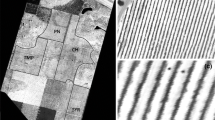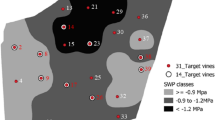Abstract
Characterizing the spatial variability in water status across vineyards is a prerequisite for precision irrigation. The crop water stress index (CWSI) indicator was used to map the spatial variability in water deficits across an 11-ha ‘Pinot noir’ vineyard. CWSI was determined based on canopy temperatures measured with infrared temperature sensors placed on top of well-watered and water-stressed grapevines in 2009 and 2010. CWSI was correlated with leaf water potential (ΨL) (R 2 = 0.83). This correlation was also tested with results from high resolution airborne thermal imagery. An unmanned aerial vehicle equipped with a thermal camera was flown over the vineyard at 07:30, 09:30, and 12:30 h (solar time) on 31 July 2009. At about the same time, ΨL was measured in 184 grapevines. The image obtained at 07:30 was not useful because it was not possible to separate soil from canopy temperatures. Using the airborne data, the correlation between CWSI and ΨL had an R 2 value of 0.46 at 09:30 h and of 0.71 at 12:30 h, suggesting that the latter was the more favorable time for obtaining thermal images that were linked with ΨL values. A sensitivity analysis of varying pixel size showed that a 0.3 m pixel was needed for precise CWSI mapping. The CWSI maps thus obtained by airborne thermal imagery were effective in assessing the spatial variability of water stress across the vineyard.









Similar content being viewed by others
References
Acevedo-Opazo, C., Tisseyre, B., Guillaume, S., & Ojeda, H. (2008a). The potential of high spatial resolution information to define within-vineyard zones related to vine water status. Precision Agriculture, 9, 285–302.
Acevedo-Opazo, C., Tisseyre, B., Ojeda, H., Ortega-Farias, S., & Guillaume, S. (2008b). Is it possible to assess the spatial variability of vine water status? Journal International des Sciences de la Vigne et du Vin., 42, 203–219.
Basile, B., Marsal, J., Mata, M., Vallverdú, X., Bellvert, J., & Girona, J. (2011). Phenological sensitivity of Cabernet Sauvignon to water stress: vine physiology and berry composition. American Journal of Enology and Viticulture, 62, 452–461.
Bellvert, J., Marsal, J., Mata, M., & Girona, J. (2012). Identifying irrigation zones across a 7.5-ha ‘Pinot-noir’ vineyard based on the variability of vine water status and multispectral images. Irrigation Science, 30, 499–509.
Berni, J. J., Zarco-Tejada, J. P., Sepulcre-Cantó, G., Fereres, E., & Villalobos, F. (2009a). Mapping canopy conductance and CWSI in olive orchards using high resolution thermal remote sensing imagery. Remote Sensing of Environment, 113, 2380–2388.
Berni, J. A., Zarco-Tejada, P. J., Suarez, L., & Fereres, E. (2009b). Thermal and narrow-band multispectral remote sensing for vegetation monitoring from an unmanned aerial vehicle. IEEE Transactions on Geoscience and Remote Sensing, 47, 722–738.
Bramley, R. G. V., & Hamilton, R. P. (2004). Understanding variability in winegrape production systems. 1. Within vineyard variation in yield over several vintages. Australian Journal of Grape and Wine Research, 10, 32–45.
Bramley, R. G. V., Proffitt, A. P. B., Hinze, C. J., Pearse, B., & Hamilton, R. P. (2005). Generating benefits from precision viticulture through selective harvesting. In J. V. Stafford (Ed.), Precision Agriculture ‘05, Proceedings of the 5th European Conference on Precision Agriculture (pp. 891–898). Wageningen: Wageningen Academic Publishers.
FAO (2010) FAO statistical database (online). Retrieved September, 2013, from http://faostat.fao.org/.
Fulton, A., Schwankl, L., Lynn, K., Lampinen, B., Edstrom, J., & Prichard, T. (2011). Using EM and VERIS technology to assess land suitability for orchard and vineyard development. Irrigation Science, 29, 497–512.
Girona, J., Mata, M., del Campo, J., Arbonés, A., Bartra, E., & Marsal, J. (2006). The use of midday leaf water potential for scheduling deficit irrigation in vineyards. Irrigation Science, 24, 115–127.
Gonzalez-Dugo, V., Zarco-Tejada, P., Berni, J. A. J., Suárez, L., Goldhamer, D., & Fereres, E. (2012). Almond tree canopy temperature reveals intra-crown variability that is water stress-dependent. Agricultural and Forest Meteorology, 154–155, 156–165.
Hipps, L. E., Asrar, G., & Kanemasu, E. T. (1985). A theoretically-based normalization of environmental-effects on foliage temperature. Agricultural and Forest Meteorology, 27, 59–70.
Idso, S. B., Jackson, R. D., Pinter, P. J., Reginato, R. J., & Hatfield, J. L. (1981). Normalizing the stress-degree day parameter for environmental variability. Agricultural Meteorology, 24, 45–55.
Jackson, R. D., Idso, S., Reginato, R., & Pinter, P, Jr. (1981). Canopy temperature as a crop water stress index indicator. Water Resources Research, 17, 1133–1138.
Johnson, L. F., Bosch, D. F., Williams, D. C., & Lobitz, B. M. (2001). Remote sensing of vineyard management zones: Implications for wine quality. American Society of Agricultural Engineers, 17, 557–560.
Jones, H. G., Stoll, M., Santos, T., de Sousa, C., Chaves, M. M., & Grant, O. M. (2002). Use of infrared thermography for monitoring stomatal closure in the field: Application to grapevine. Journal of Experimental Botany, 53(378), 2249–2260.
Martinez-Casasnovas, J. A., Vallés Bigorda, D., & Ramos, M. C. (2009). Irrigation management zones for precision viticulture according to intra-field variability. In A. Breft, S. Wolfert, J. E. Wien, & C. Lokhorst (Eds.), EFITA conference’09. Proceedings of the 7th EFITA Conference (pp. 523–529). Wageningen: Wageningen Academic Publishers.
Möller, M., Alchanatis, V., Cohen, Y., Meron, M., Tsipris, J., Naor, A., et al. (2007). Use of thermal and visible imagery for estimating crop water status of irrigated grapevine. Journal of Experimental Botany, 58(4), 827–838.
Rogiers, S. Y., Greer, D. H., Hatfield, J. M., Hutton, R. J., Clarke, S. J., Hutchinson, P. A., et al. (2012). Stomatal response of an anisohydric grapevine cultivar to evaporative demand, available soil moisture and abscisic acid. Tree Physiology, 32, 249–261.
SAS. (2002). Enterprise Guide version 4.2 (SAS Institute Inc. Cary, NC, USA).
Sepulcre-Canto, G., Zarco-Tejada, P. J., Jimenez-Muñoz, J. C., Sobrino, J. A., de Miguel, E., & Villalobos, F. J. (2006). Detection of water stress in an olive orchard with thermal remote sensing imagery. Agricultural and Forest Meteorology, 136, 31–44.
Testi, L., Goldhamer, D. A., Iniesta, F., & Salinas, M. (2008). Crop water stress index is a sensitive water stress indicator in pistachio trees. Irrigation Science, 26, 395–405.
Turner, N. C., & Long, M. J. (1980). Errors arising from rapid water loss in the measurement of leaf water potential by pressure chamber technique. Australian Journal of Plant Physiology., 7, 527–537.
Van Zyl, J. L. (1987). Diurnal variation in grapevine water stress as a function of changing soil status and meteorological conditions. South African Journal of Enology and Viticulture, 8(2), 45–52.
Wetterlind, J., Stenberg, Bo, & Söderström, M. (2008). The use of near infrared (NIR) spectroscopy to improve soil mapping at the farm scale. Precision Agriculture, 9, 57–69.
Williams, L. E., & Arujo, F. J. (2002). Correlations among predawn leaf, midday leaf, and midday stem water potential and their correlations with other measures of soil and plant water status in Vitis vinifera. Journal of the American Society for Horticultural Science, 127, 448–454.
Zarco-Tejada, P. J., González-Dugo, V., & Berni, J. A. J. (2012). Fluorescence, temperature and narrow-band indices acquired from a UAV platform for water stress detection using a micro-hyperspectral imager and a thermal camera. Remote Sensing of Environment, 117, 322–337.
Zia, S., Klaus, S., Nikolaus, M., Wenyong, D., Xiongkui, H., & Müller, J. (2009). Non-invasive water status detection in grapevine (Vitis vinifera L.) by thermography. International Journal of Agricultural and Biological Engineering, 2(4), 46–54.
Acknowledgments
This work received partial financial support from SUDOE for the European project Telerieg SOE1/P2/E082 and the Spanish Ministry of Science and Innovation (MCI) for the project CONSOLIDER CSD2006-00067 and AGL2009-13105. We are grateful for the opportunity to carry out this study under the research agreement between CODORNIU and IRTA. The authors thank the team of Quantalab, IAS-CSIC of Córdoba, for the technical support in field airborne flights and image processing. José Antonio Jiménez Berni, Alberto Hornero, Rafael Romero, David Notario, Alberto Vera, Jaume Casadesús, Jordi Marsal and Victoria González-Dugo are especially acknowledged for the technical support with data analysis and useful comments. Jesús del Campo, Mercè Mata, Carles Paris, Núria Bonastre and Xavier Vallverdú are acknowledged for field measurements. We are grateful to Prof. Hossein Behboudian, from Massey University in New Zealand, for his critical review of an early version of this manuscript.
Author information
Authors and Affiliations
Corresponding author
Rights and permissions
About this article
Cite this article
Bellvert, J., Zarco-Tejada, P.J., Girona, J. et al. Mapping crop water stress index in a ‘Pinot-noir’ vineyard: comparing ground measurements with thermal remote sensing imagery from an unmanned aerial vehicle. Precision Agric 15, 361–376 (2014). https://doi.org/10.1007/s11119-013-9334-5
Published:
Issue Date:
DOI: https://doi.org/10.1007/s11119-013-9334-5




